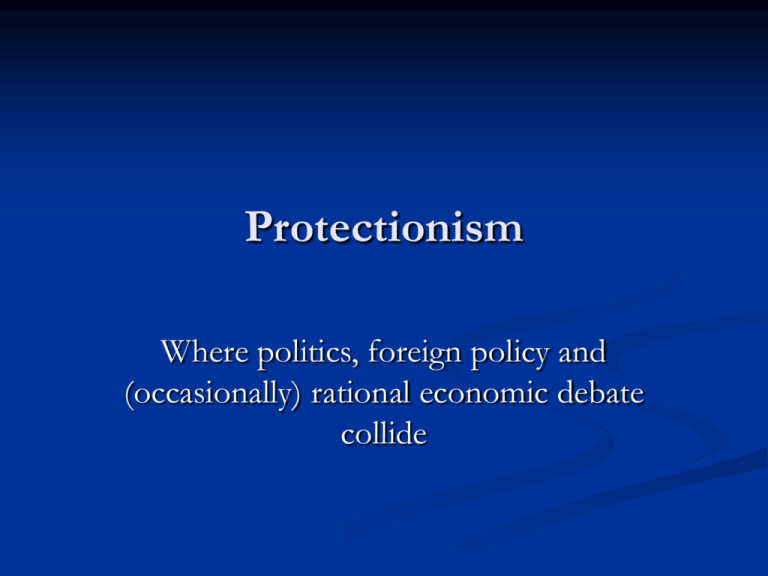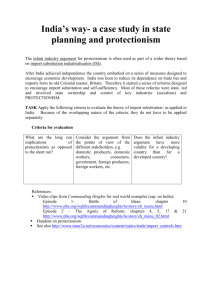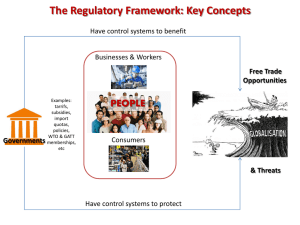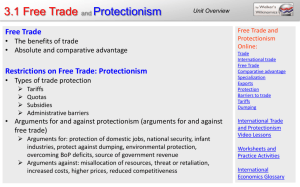Protectionism - robertwieckowski
advertisement

Protectionism Where politics, foreign policy and (occasionally) rational economic debate collide Protectionism Definition: Imposition of trade barriers in order to protect domestic producers By definition, protectionism is a topic that involves politics as much as “pure” economics But for the moment … let’s stick with economics Types of Protectionism Direct Embargo Tariff Quota Subsidy Indirect Voluntary Export Restraint (VER) Exchange rate controls Import licenses Regulatory and administrative barriers Embargo A total ban on trade Can be applied by domestic governments or imposed by foreign governments Examples Jefferson’s Embargo Act (1807) U.S. embargo of Iraq post Gulf War Often used as an economic weapon to achieve foreign policy objectives Implications of an Embargo Embargo = elimination of trade = pure domestic market Prices go up (consumers pay more) Domestic producers lose the opportunity to sell their products in foreign markets but benefit from higher prices for their goods domestically Equilibrium Without Trade Domestic Supply Consumer Surplus Pd Producer Surplus Domestic Demand Qd Impact of Trade To understand the impact of trade, you must start with an analysis of relative prices and comparative advantage If the domestic equilibrium price for a product is lower than the world price – the country will become an exporter of this product If the domestic equilibrium price is higher than the world price – the country will import the product from foreign suppliers Who Wins and Who Loses? To simplify our analysis, assume that the world price is a given – the actions of our small, insignificant country have no impact on the prevailing world price Graphically, this assumption is represented by a flat supply curve at the world price (i.e. we can import or export unlimited quantities at that price) Impact on an Exporter Consumer Surplus Domestic Supply Exports World Price Producer Surplus Domestic Demand Impact on an Exporter When a country is an exporter, generally consumers lose (higher prices, reduction of consumer surplus) But, domestic producers gain (higher prices and increased production) Higher production translates into more jobs, happy constituents and reelected politicians Domestic economy realizes a net benefit Impact on an Importer Domestic Supply Consumer Surplus World Price Producer Surplus Imports Domestic Demand Impact on an Importer When a country is an importer, consumers benefit (lower prices and higher consumer surplus), but domestic producers lose (lower prices, decreased production) Reductions in domestic production means job losses and often an increase in political rhetoric and calls for the government to protect domestic industries from foreign competition, despite the fact the overall economy realizes a net benefit from trade Tariff The most common restriction on trade is a tariff Tariff = tax on imported goods Results of a tariff: Prices go up Domestic production increases Government gets more revenue Effects of a Tariff Domestic Supply Price with Tariff Imports World Price Domestic Demand Qs1 Qs2 Qd2 Qd1 Quota Another very common restriction on trade is the quota A quota is a limitation on the quantity of a good allowed to be imported into a country Quotas limit the impact of international trade on the domestic market Usually enforced through government issued permits to trade Quota (Cont’d) Impact of quotas: Domestic prices go up (consumers pay more) Domestic producers increase production Government gets more revenue (import license fees) Let’s go to the graph … Impact of a Quota Domestic Supply Supply with Import Quota World Price Quota Domestic Demand Q1 Q2 Q3 Subsidy Government payment to producers in order to either reduce the impact of imports or make a country’s exports more competitive First, let’s examine the impact of an import subsidy … Import Subsidy Domestic Supply with no subsidy Domestic Supply with subsidy World Price Domestic Demand Q1 Q2 Q3 Export Subsidy An export subsidy enables domestic producers to lower their prices in the world market below their true cost of production, a otherwise known as dumping (and a definite WTO violation) Export subsidies protect domestic producers from foreign competition and increase domestic production and employment – very tempting outcomes for governments Which leads to predictable accusations and figure pointing during international trade negotiations Indirect Protectionism Voluntary Export Restrictions Self-imposed export restrictions Can be imposed on a firm upon itself, an industry upon itself, or by a domestic government over domestic producers Negotiation tool to avoid trade wars and stay within WTO rules Exchange Rate Controls Limitation on amount of foreign currency available to importers Indirect Protectionism (Cont’d) Import Licensing Government issued licenses required to import goods In practice, works like a quota Regulatory and Administrative Barriers Regulations that increase the cost of production for imported goods Can take the form of safety standards, environmental controls, terrorism laws Arguments for Protectionism Infant Industry Argument In theory, used to provide “temporary” protection for domestic producers during their early stage of development in order to give them time to grow and develop economies of scale Argument also used to justify protection for declining industries to give them time to restructure In practice – “temporary” can be a very long time Arguments for Protectionism (Cont’d) The Exploitation Argument Workers in developing countries are exploited by MNCs and domestic firms are forced to cut corners in order to compete Activist groups push for restrictions (especially through regulation) by developed nations Rebuttal – Workers in developing countries are relatively better off from trade; restrctions only make goods more expensive and force MNCs out of developing nations Arguments for Protectionism (Cont’d) The Jobs Argument Trade destroys domestic jobs Rebuttal – Depends on which jobs you are talking (or care) about; trade costs some jobs and creates others; any attempt to protect domestic employment will create inefficiency and reduce long-term competitiveness Arguments for Protectionism (Cont’d) National Security Argument We must protect industries that are “vital to our national security” Trade makes us more vulnerable to terrorism Rebuttal – “Vital to national security” is very broad, tough to define, and often in the eye of the beholder; trade creates economic interdependency that builds political bridges and mutual interests Arguments for Protectionism (Cont’d) Unfair Competition Argument The “they don’t play fair” argument Foreign governments subsidize exports We face a tougher regulatory environment They are dumping products in our market Rebuttal – Very slippery slope; we should lead by example; a shift toward protectionist policies will hurt everyone And Finally … Bargaining Chip Argument Protectionism as a tool of foreign policy Use threat of trade restrictions as a bargaining chip to get concessions from our trading partners Rebuttal – Using trade as a political weapon has the potential to snowball with very negative consequences, so if (when) we employ this tactic – it better work






